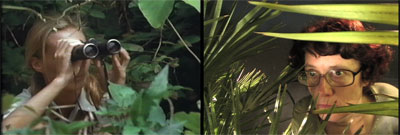
Humans are capable of such funny contradictions. Take, for instance, our proclivity to forget that we, too, are animals, while nonetheless looking to other primates in an effort to further study ourselves. In a video series entitled "Primate Cinema," Rachel Mayeri dives headfirst into this often comic dilemma. Three videos in this series are currently on view at Los Angeles' TELIC Arts Exchange, and each takes the increasingly popular primate narrative genre as its starting point to build "an observation platform for viewing the social, sexual, and political behavior of human and nonhuman primates." In Jane Goodall and the Wild Chimpanzees we see a live performance of a classic nature documentary, developed and taped as the result of a three-week workshop at TELIC. The piece explores the documentary medium and the work it does to dramatize scenarios, despite its presumed objectivity. How to Act like an Animal also unfolded from a workshop--in this case co-led by primatologist Deborah Forster and theater director Alyssa Ravenwood. The tasks rehearsed speak to common perceptions of the primitivity of non-human animals, with the close study and re-interpretation of a nature documentary leading to the act of "hunting, killing, and sharing the meat of a colobus monkey." An earlier video in the series, Baboons as Friends, reaches beyond the model of pure consumption and survival to explore the emotional and social lives of primates. Shot with human actors in a film noir style, the piece explores the ways in which "lust, jealousy, sex, and violence transpir[e] simultaneously in human and nonhuman worlds." While entertaining, the videos also taxonomize and observe the field of primate studies as a model of inquiry and a classic medium of scientific thought. If anything, Mayeri's work takes a compelling look at the evolution of a field crafted to study our own evolution. - Marisa Olson
Image: Rachel Mayeri, Jane Goodall and the Wild Chimpanzees, 2008